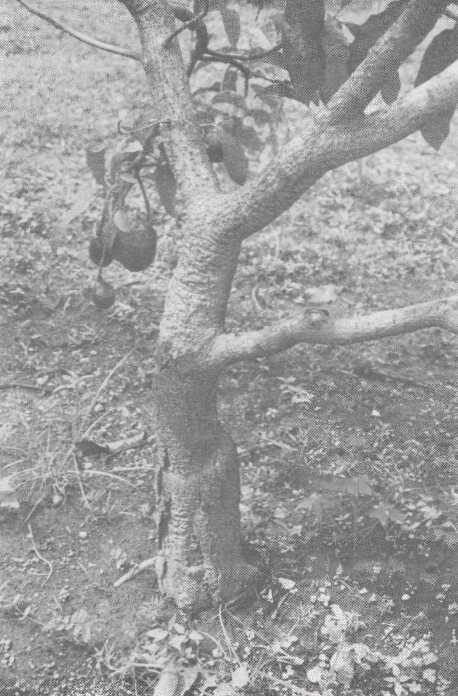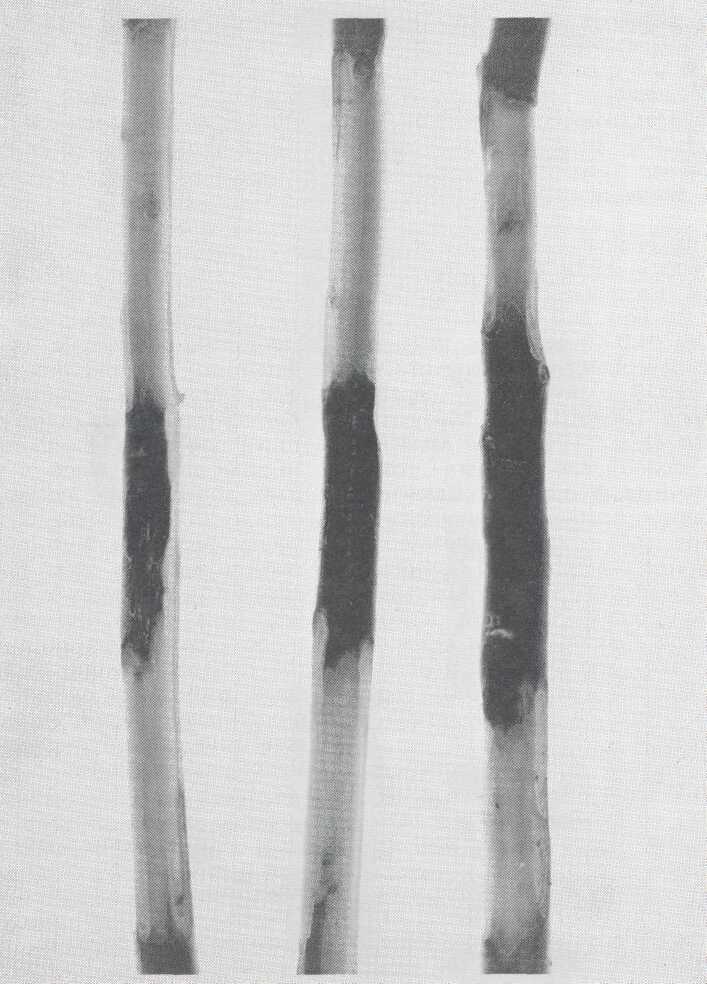Proc. of Second World Avocado Congress 1992 pp. 133-137
A Unique Trunk Canker of
Avocado in Guatemala Caused by Phytophthora
heveae
George A. Zentmyer
University of California, Riverside, CA 92521, USA
Wilson Popenoe
Deceased
Eugenio Schieber
Antigua, Guatemala, Central America
Abstract. A unique trunk canker was first observed by Wilson Popenoe and called to our attention in January, 1973, on
trunks of avocado trees in a Ministry of Agriculture Nursery variety planting
at Los Aposentos, near Chimaltenango, Guatemala. Cultures from bark samples yielded a homothallic
species of Phytophthora that we
identified as P. heveae. This is the first
report of this pathogen on avocado, and the first occurrence in Guatemala of this fungus. The canker caused considerable
damage on the young (three- to four-year-old) trees; some were girdled and
killed. The trees were on Guatemalan criollo seedling
rootstocks, with scions from Guatemala, Honduras, and Hawaii.
The occurrence of a new pathogen causing trunk
cankers on avocado was reported briefly in the California Avocado Society
Yearbook in 1975 (Zentmyer et al.), and
in the Plant Disease Reporter in 1978 (Zentmyer et
al.). This paper provides more detail on this uncommon species of Phytophthora in Latin America, and on the disease progress since the original
observation by Dr. Wilson Popenoe in 1973.
Materials and Methods
This new disease problem was reported to us by Dr. Popenoe in January, 1973, and we visited the nursery that
month and collected samples in the course of one of G.A. Zentmyer's
trips to Latin America in connection with the University of California, Riverside, project on the search for avocado rootstocks
resistant to Phytophthora cinnamomi root rot. Affected trees were 3 to 4 years
old when the first cultures were made, and had
cracked and bleeding cankers on the lower trunk and upper part of the rootstock
(Fig. 1). Excision of the cankers revealed definite reddish-brown margins
leading into healthy tissue. Lesions were generally in the bark, but
occasionally extended into the outer xylem. Diseased trees were off-color, and
where the cankers had nearly or completely girdled the lower trunk the tops
were severely wilted, and some trees had died by 1974.
Isolations were made by the senior author using small
pieces of bark from the active margins of the lesion on the lower trunks of the
small trees. Bark pieces were plated on media selective for Phytophthora
in an improvised hotel room laboratory in Antigua the day of collection. Isolations were made again from the same
planting in 1974 and 1977.
Results

Figure 1.
Typical canker caused by Phytophthora heveae on young avocado tree in Guatemala. Photo by Schieber.
An obvious species of Phytophthora
grew readily from a high proportion of the bark pieces cultured within two
to three days. Cultures were examined a few days later on my return to Riverside, California. This turned out to be a homothallic species of Phytophthora that produced abundant oospores in a few days at 24C on V8 agar.
As we had previously isolated a homothallic species
of Phytophthora from trunk cankers in
southern California in the 1960's and identified this as P. citricola (Zentmyer et al.,
1974), there was a good possibility that this was the same fungus. Further
microscopic study revealed that the Guatemalan isolate was a different species
of Phytophthora, P. heveae
Thompson.
Phytophthora heveae is distinguished by the unique form of the antheridium and oogonium, with an
elongate antheridium and a balloon-shaped oogonium. This is quite different from the antheridium and oogonium in P.
citricola, and also P. cactorum,
the other homothallic species that was reported on avocado many years ago.
The antheridia are amphigynous, thus distinct from P.
cactorum which has paragynous
antheridia. Sporangia were formed readily on V8 agar and other agar media, and
are somewhat irregular in shape, with the sporangiophore
sometimes attached laterally. More details on the fungus mycelium, sporangia
and oospores are given in our 1978 paper (Zentmyer et al.).
Waterhouse (1956) describes P. heveae
as follows: "Range of sporangia 27-66 x 20.5-48 µm, average
size of 400:45.9 29.62. Mean ratio of length to width = 1.55. Oogonia and oospores freely
formed on potato dextrose agar media and also in water. Oogonia
broadly funnel shaped with amphigynous antheridia. Oospores round, smooth, and thick walled, not always
colored distinctly. Range of 200 oogonia = 17-32 µm, mean = 25.9, range of 250 oospores = 15-26.8 µm, mean =
21.46."
Inoculations of stems of young avocado seedlings (cv. Topa Topa)
with two Guatemalan isolates of P. heveae in
the greenhouse resulted in rapid development of lesions with growth similar to
cankers formed by P. cinnamomi (Fig. 2). Cankers
produced by P. heveae averaged 6.2 cm in 8
days; P. cinnamomi cankers averaged 4.7 cm.
The original description of P. heveae
was in 1929 by Thompson in Malaysia. He reported the fungus as parasitic on bark and
fruit of Heveae brasiliensis
(H.B.K.) Muell. P. heveae
has been described on additional hosts since 1929, including cacao (Theobroma cacao L.) in Malaysia, Brazil (Luz et al.,
1989), and Mexico (Lozano-Trevino and Romero-Cova,
1984); rhododendron in North Carolina (D.M. Benson, personal communication),
pine soil in the southeastern United States (Campbell and Gallegly, 1965), Eucalyptus
soil in Australia (Gerrettson-Cornell, 1976), a
forest tree (Agathis australis)
in New Zealand (Gadgil, 1974), and Brazil nut
trees in Brazil (Albuquerque eta/., 1974).
The fungus is a common pathogen on rubber in Malaysia.
P. heveae is not a common pathogen in Latin America; this is the first report on avocado, and the first
report of the fungus on any host in Guatemala.
The nursery in Guatemala was visited again in 1974 and 1977. At the time of
the original isolations there was considerable damage on the avocado trees;
several trees were girdled and had died. When additional notes were taken in
1977, 30 percent of the 223 trees in the nursery variety plantings had either
been removed or were very severely
diseased. The trees in the plantings were all on local Guatemalan "criollo" seedling rootstocks, with scions from
Guatemala, Honduras, and Hawaii including 'Siquinala',
'Chocola 5', 'Rinconada', 'Zamorano 10', and 'Haankuu
Hawaii'. The planting did not make good growth overall, and was removed in the
mid-1980's.
This canker has not been observed on any other
avocado trees in Guatemala, or on any other host in that country. To date this
pathogen has not been found in California on avocado, nor reported from any other country on
avocado. There are few records of the species in Latin America, in Mexico and Brazil.
Discussion
The reason for this curious isolated occurrence of a
new pathogen on the small nursery planting in Los Aposentos, Guatemala, is difficult to determine. At the time of our first
visit there were a number of young nursery trees still in nursery rows prior to
planting in the field there or moving to other groves. None of these small
trees showed any indication of the canker. There were a number of young
deciduous fruit trees in the nursery and in a small field planting adjacent to
the avocado field planting, with no evidence of disease development. The
cankers were primarily on the rootstock portion of the grafted trees, with
lesions spreading from the ground level upward, so the infection must have come
from the soil or from the original seedlings.
Literature Cited
Albuquerque, F.C., M.L.R. Duarte, G.R. Manco, and H.M. Silva. 1974. [Leafblight of Brazil nut (Bertholletia excelsa)
caused by Phytophthora heveae.]. Requeima das folhas da
castanheira do Para (Bertholletia excelsa)
casuada por Phytophthora heveae. Pesqui. Agropecu.
Bras., Ser. Agron. 9:101-105.
Campbell, W.A. and M.E. Gallegly. 1965. Phytophthora
heveae from eastern Tennessee and western North Carolina. Plant Dis. Reptr.
49:233-234.
Gadgil,
P.D. 1974. Phytophthora heveae,
a pathogen of kauri. N. Z. J. for Sci. 4:59-63.
Gerrettson-Cornell, L 1976. Phytophthora heveae and P. boehmeriae in a Eucalyptus pilularis
plantation in New South Wales. Austral. Plant
Pathol. Soc. Newsl.
5:8-9.
Lozano-Trevino, Z.E. and S. Romero-Cova. 1984. Estudio taxonmico
de aislamiento de Phytophthora patogenos de cacao. Agrociencia 56:175-182.
Luz, E.D.M.H., S D.V.M. Silva, and DJ. Mitchell. 1989. Phytophthora
heveae: outra especie causando podridao pardado cacaueirona Bahia. Fitopatologia Bras. 14:160 (Abstr.).
Thompson, A. 1929. Phytophthora species in Malaysia. Malaysian Agric. 17:55-100.
Waterhouse,
G.M. 1956. The Genus Phytophthora.
Commonwealth Mycological Institute Misc. Publication 12,
120pp.
Zentmyer, G.A., L. Jefferson, C.J. Hickman, and Y. Chang-Ho.
1974. Studies of Phytophthora citricola,
isolated from Persea americana. Mycologia
66:830-845.
Zentmyer,
G.A., LJ. Klure, and E.G. Pond. 1978. A new canker disease of avocado
caused by Phytophthora heveae.
PI. Dis. Reporter 62:918-922.
Zentmyer, G.A., E. Schieber, and W.
Popenoe.
1975. Phytophthora canker of avocado trees
in Guatemala. Calif. Avocado Soc. Yrbk. 58:136-137.

Figure 2.
Lesions caused on stems of Persea indica by inoculation with P. cinnamomi
(left) and P. heveae culture from Guatemala (center and left).

